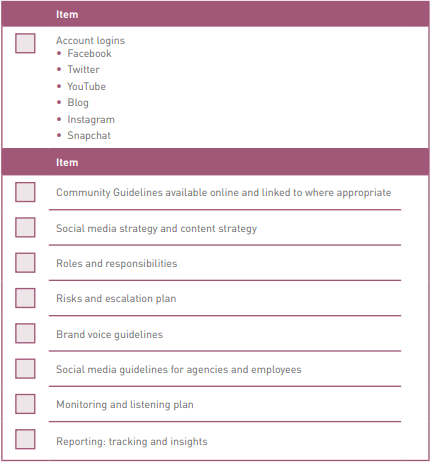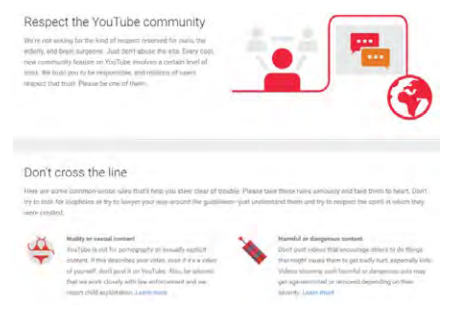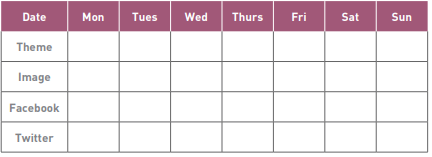17.5: Documents and processes
- Page ID
- 24967
Good documentation and processes are the foundations of social media success and your social strategy is likely to involve many stakeholders from across your organisation. Processes and guidelines ensure consistency across the various channels. These should be created, agreed on, and approved before you take any action on social media.
Start with the documentation and processes you already have in place for marketing and communication, for example, brand and tone of voice guidelines, or PR policies. Build on these to create a robust foundation that suits this spontaneous, dynamic space.
A social media checklist is a good starting point to make sure that you have everything in place. Examples of the checklist, conversation calendars and escalation protocols are also included for you.

Community guidelines
As well as a privacy policy and terms and conditions, it’s a good idea to establish community guidelines for the communities you manage, especially when the community is on behalf of a brand. Community guidelines help to set the tone for the community, and are useful to refer to should members behave in a way that is undesirable. Guidelines indicate what will, and will not, be tolerated, such as hate speech, profanity, discrimination, or other inappropriate content. Of course, community guidelines don’t prevent such behaviour, but are useful to fall back on should you need to remove comments or community members.
Guidelines should be friendly, with the tone in keeping with your community or brand.
Many social media platforms provide their own guidelines that all users, including brands, have to adhere to. Failure to adhere to any of the guidelines could get you removed from the platform.

As well as recommendations for members’ conduct and the types of material that can and cannot be shared, guidelines should include information about how and who to report violations to. Methods for members to protect their personal information and intellectual property are also important things to include.
Content plan
Content plans help you to plan your community conversations and the messages you send. We suggest weighting your content to your objectives. Decide on what you want to achieve with each objective, and by when, and what level of priority it is for your business. Map these objectives weekly and monthly as necessary. Then create weekly or monthly content plans around these objectives, based on each objective’s relative priority for your business per week.
For example, if your objectives are brand awareness, sales and app installs, you need to weight them according to their importance. If your main objective on social media is brand awareness, make this 50% of your content plan. This means that 50% of all content you post will be aimed at increasing brand awareness. If the other two objectives are equivalent, then content driving sales and content driving app installs should each make up 25% of your content plan. If this changes over time, so that in week three, you want app installs to be your most important objective, then content driving app installs becomes 50% of your content plan, with content promoting brand awareness dropping down to making up only 25% of your content plan.
Content plans are useful, centralised planning documents that ensure that various teams are all aware of each other’s efforts, and that communications are integrated. For any kind of content and communication strategy, content plans are invaluable. Be sure your content plan speaks to your objective, your brand identity, your chosen target audience, and the themes or topics you have selected.
As you learnt in the Content marketing strategy chapter, reaching social audiences requires that you create content that truly resonates with them. Successful social content must be interesting, relevant, shareable, and remarkable. It is especially useful to plan and create social content around your content pillars, since this gives you a solid structure and starting point to follow.
Read more about this in the Content marketing strategy chapter.
To start creating a conversation calendar, you should plot everything that is relevant to your community. This could include public events, dates and anniversaries, or events and communications already planned by your organisation.
You should also use your conversation calendar for reporting. Keeping track of interactions and responses to your planned posts will help you to determine what kind of posts your community responds to, what days are best for posting, and what frequency works best for your community.
CoSchedule, a content marketing editorial calendar software, provides some guidance on how often to post on each platform. Some platforms like Twitter and Pinterest require frequents posts each day, while Facebook, Instagram and LinkedIn require less posts (Neidlinger, 2016). However, with platform algorithms changing all the time, the frequency of posts is becoming less important. A great post will circulate and appear in newsfeeds for much longer because it has good relevant content.
Brands should only post content relevant to their objectives and not to fill spaces on a content calendar. Posting poor content to meet a prescribed number of posts, may end up negatively impacting on your brand. Because of the algorithms, competition for brands to create good content is becoming intense, but ultimately the user will get to experience better organic content. Some brands may have to resort to paid media to get their posts seen at all. Ultimately the content you choose to create and the frequency of your posts, should be informed by your community on each platform.
Planning the conversation helps to keep momentum, especially in the early days of building a community. However, it should not replace spontaneity, this is a conversation, after all!

There are many fields that can go into a conversation calendar (such as suggested copy, links, and more). Take the basic calendar provided in Figure 9. and adapt it to your needs and preferences.
Communication and escalation protocol
An established communication and escalation protocol helps to ensure that all parties are aware of procedures for handling social messages, and can respond as appropriate. This is especially important for large organisations where several users might be interacting in social media on behalf of a brand, or where several departments or agencies have a stake in the organisation’s social media presence.
A communication and escalation protocol should include:
- Anticipated messages, frequently asked questions and appropriate, standard responses (for both positive and negative situations).
- Guidelines for determining the sentiment and risk of messages, which includes a flagging system for comments that need more senior attention.
- The crisis management process to follow if a brand crisis erupts on social media.
- An escalation plan for messages that need signoff or further consideration.
Make sure that all stakeholders understand their roles, and appreciate that social media interactions often need to be handled quickly.
- Contact details of relevant stakeholders.
- Guidelines for responding, including response rate, standard messages, brand voice and tone.

* Note: this process was created predominantly for Facebook, but these basic principles apply to most social media networking platforms.
Adapted From Stokes, 2013


